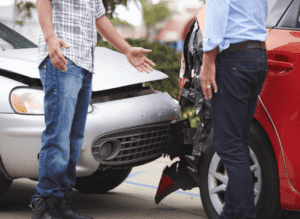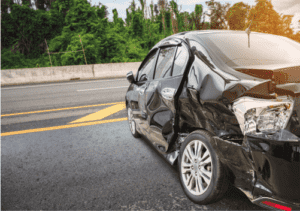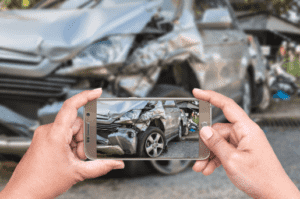
What To Do After A Car Accident [Step-by-Step Guide]

It’s every driver’s nightmare: a car accident. It’s frightening and frankly, often overwhelming. In the moments after a car accident, you often don’t know what to do. Do you call someone? Do you exchange information with the other driver? What if you’re hurt? Should you call the police? Should you stay in your car?
- So many questions.
- Your head is spinning.
- You need information and you need it quick.
We’re here to provide answers. In this article, we’re going to give you a step-by-step guide for what you should if you’re in a car accident.
You may want to consider printing this out and putting in your glove box for reference in the event of an accident.
Step #1: Don’t Leave The Scene
This should be obvious, but it must be said. Never leave the scene of a car accident until every aspect has been fully processed. This point is particularly relevant if someone was injured. If you leave the scene of an accident where someone was injured or even killed, you can be charged with serious criminal offenses.
Always, always, always stay at the scene of the accident.
Step #2: Check Yourself and Your Passengers For Injuries
Before doing anything else, check both yourself and your passengers for injuries. If anyone has been injured, call 911 immediately. If you have been seriously injured, try to move as little as possible and wait for emergency personnel to arrive on the scene.
Unless it is absolutely necessary (such as if your car is on fire), do not try to move an injured person yourself. You risk further injury to the person. Wait until trained medical professionals arrive on the scene.
Step #3: Get To Safety
If possible, move to the side of the road or a sidewalk. If your car is driveable, move it to the side of the road as well. You don’t want to be sitting in the middle of the road in a disabled car, as you run the risk of being hit by another car.
If you have an emergency road kit, place the road flares a safe distance from your disabled car to warn other drivers to slow down.
Step #4: Call The Police
 Unless the accident is a very minor fender bender, you should almost always call the police. In fact, it’s mandatory in some states. The police officer(s) will both fill out an accident report and document the scene.
Unless the accident is a very minor fender bender, you should almost always call the police. In fact, it’s mandatory in some states. The police officer(s) will both fill out an accident report and document the scene.
Request that a police report be filed and also obtain the names and badge numbers of the responding officers. This information may be necessary for a variety of reasons, including if you need to take legal action as a result of the accident or if you file an insurance claim.
Step #5: Exchange Information With The Other Drivers
After ensuring that everyone is safe, find the other driver(s) involved in the accident and exchange information with them. The most important information to secure is:
- Full name and contact information
- Insurance company and policy number
- Driver’s license and license plate number
- Type, color, and model of vehicle
- Location of accident
One critical thing to note. When exchanging information, do not discuss whose fault the accident was. If you apologize for something, such crossing into another lane, you may be admitting legal liability for the accident.
Additionally, in many cases, when you file your insurance claim, the adjuster will review things such as information provided by you and the other parties, the police report, photographs from the scene, and any other supporting documentation. The adjuster will then determine who is at fault for the accident.
We realize that in the chaos following an accident, you may be tempted to apologize, particularly if you feel that you were at fault. However, this is almost always detrimental to you.
Step #6: Document The Accident
 In order to protect yourself, as well as have sufficient documentation if you need to file any sort of claim, you should document the accident as much as possible. This includes:
In order to protect yourself, as well as have sufficient documentation if you need to file any sort of claim, you should document the accident as much as possible. This includes:
- Taking photographs of both cars from numerous angles. Try to show what sort of damage was done to both cars. Additionally, if possible, take photos of the other car’s license plate. Photos will help the insurance adjuster determine how much you should be compensated and can also be useful in court.
- Identify the police officers on the scene (name, badge number, etc.), and ask the officers where you can get a copy of the accident report.
- Get the names and addresses of all the parties involved in the accident. This includes passengers in the other vehicle.
- If anyone witnessed the accident, get their names and contact information as well.
Your goal in all of this is to be able to recreate the accident as thoroughly as possible for any interested parties (legal, insurance, etc.).
Step #7: Notify Your Insurance Company
You should promptly notify your insurance of the accident. It’s absolutely critical that you thoroughly cooperate with them and tell them the truth about the accident. Be clear on the extent of your injuries.
If your insurance company determines that you lied to them, it can cause significant problems for you, including complete denial of coverage. If a police report has been filed, review it so that you can be clear on what traffic laws were broken and who was at fault.
Step #8: Track Medical Treatment
 If you have been injured in the crash, it’s absolutely essential that you track the treatments you receive. If you are treated by a doctor, therapist, chiropractor, or any other medical professional for injuries sustained in the crash, make note of that for future reference. Keep a log of different treatments and medications you receive.
If you have been injured in the crash, it’s absolutely essential that you track the treatments you receive. If you are treated by a doctor, therapist, chiropractor, or any other medical professional for injuries sustained in the crash, make note of that for future reference. Keep a log of different treatments and medications you receive.
Additionally, if possible, note how the accident has impacted your daily life. Your goal is to document any pain and suffering caused by the accident. This should include things like activities you can no longer do, missed work, etc.
Step #9: Get An Independent Valuation Of The Damage
If you’re dissatisfied with how your insurance company has valued your vehicle (and the damage done), consider getting at least two independent repair or replacement quotes. Tell your adjuster about the concerns you have and share the quotes with him. If an agreement can’t be reached, you may need to hire an attorney.
Step #10: Pause Before Taking Settlement Offers
Before taking a settlement from your insurance company, stop and think things through carefully. Have all your injuries been thoroughly treated? Keep in mind that some injuries don’t appear for weeks or even months after a car accident. Don’t jump too quickly to take a settlement. Before you agree to settle, it’s wise to consult with an attorney.
Step #11: Hire An Attorney
If anyone was hurt in the car accident, it’s almost always best to hire an experienced attorney. They can ensure that you’re fairly compensated for your injuries and effectively defend you if you were at fault in the crash.
If you’re concerned about the cost, many attorneys only take compensation if you’re awarded damages or get a settlement.
Final Thoughts: Be Safe, Be Thorough
If you’re in a car accident, your first priority is safety, both for you and for anyone else involved. Do whatever is necessary to get out of harm’s way. Once you’ve done that, be thorough in how you document the scene and collect information. Every piece of information you collect may be useful at a future date.
In the days following the car accident, consider hiring an attorney to help you deal with the aftereffects of the crash. This includes both dealing with the insurance companies and recovering from your own injuries. Not sure if you need an attorney? Click here.
The simple truth is that car crashes are never pleasant. However, by following the steps above, you can recover from your crash and be compensated fairly.
Dolman Law Group
800 North Belcher Road
Clearwater, FL 33765
https://www.dolmanlaw.com/what-to-do-after-a-car-accident/
